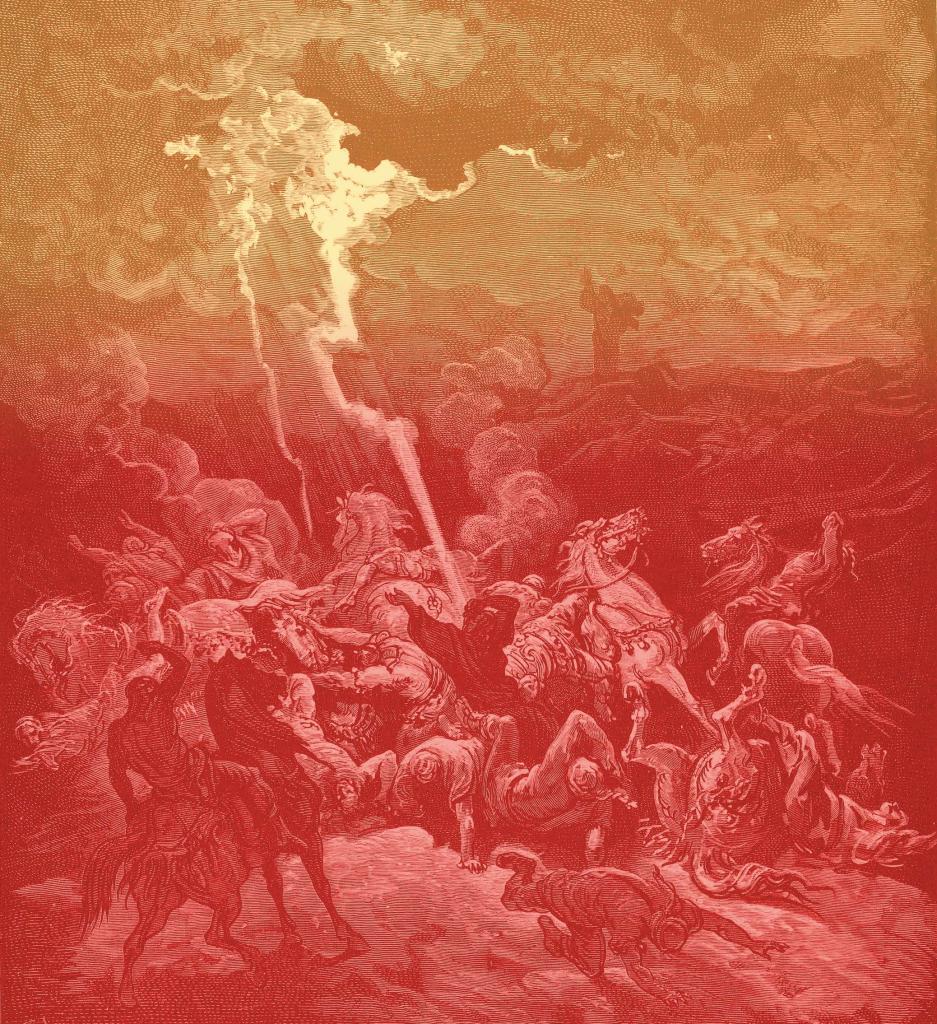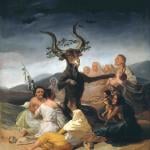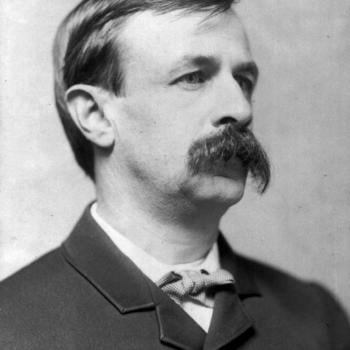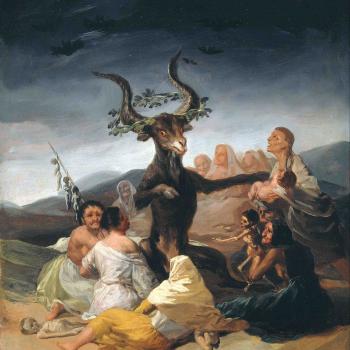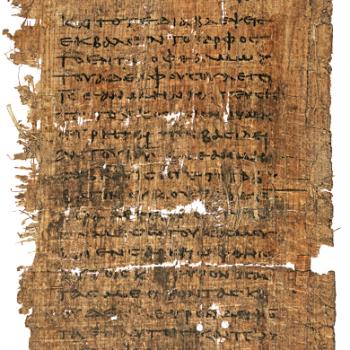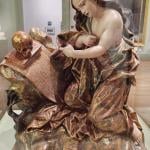We have a guest blog today from my good friend Kevin Barron – more properly, the Rev. Kevin Barron, as he is an Episcopal priest. Like many of us, he has been deeply impressed by the current hit film Sinners, by Ryan Coogler, which is assuredly destined for glory at next year’s Academy Awards. But Kevin goes well beyond conventional enthusiasm for the film, which he has been exploring with the passion that others devote to the Rocky Horror Picture Show.
He recently delivered a presentation on the film that found a really enthusiastic audience because it was so perceptive, and did such a fine job of uncovering Biblical and Christian resonances that had certainly not occurred to me. His emphasis on prophetic themes is really insightful. To state the obvious, never underestimate the power of that prophetic dimension in understanding Black American history, or of Black culture more generally.
At my request, he expounds his major points in a blog post, for which I am truly grateful.
Biblical and Christian Images in the Movie Sinners
I will begin with a quick synthesis for anyone who has not yet had the chance to see this wonderful film!
The film takes place in 1932 during the era of Jim Crow segregation and the rampages of the Ku Klux Klan. The twin brothers Elijah and Elias Moore, “Smoke” and “Stack”, return from Chicago after a seven-year absence to their hometown of Clarksdale, Mississippi to open a juke joint.
Prior to their time in Chicago, the brothers served as soldiers in the First World War, presumably in one of the legendary Black units that so impressed the Germans that they gave them the title of “Hell Fighters.” As soldiers, the twins acquired the skills that would serve them well in the Chicago crime world, where Elijah (Smoke) worked for the Irish mob and Elias (Stack) for the Italian mob. The brothers successfully played the crime enterprises against one another and left Chicago well-equipped with money and alcohol, and with enough business acumen to ensure the financial success of their new enterprise.
As the movie progresses and as they successfully navigate the obstacles and opposition of life in the segregated south, they come to discover an even greater evil than the Klan—a thousand-year-old vampire. As one-character sums it up during one of the film’s opening scenes, “You keep dancing with the devil, one day he’s gonna follow you home.”
Since its release in April of this year, the film has gained tremendous success and for some like me, a loyal following. For others, it is characterized as a disappointing horror movie that can’t decide whether to be a film or a musical. Some even view it as anti-Christian, because of its incorporation of elements of African, Irish, and Choctaw native spiritualities. It’s this last contention that I disagree with. I see strong biblical references in the film. They don’t immediately hit you in the face, but they become evident in the names of the characters, how they are presented, and through their actions.
The Key Characters
Sammie
The opening scene takes place in a small African American church on the Sunflower plantation, where the pastor is the father of the film’s protagonist, Sammie Moore. The sermon he is preparing for worship the next day centers upon a passage from I Corinthians which he asks Sammy to read aloud. Sammy proceeds to read the text, “No testing has overtaken you that is not common to everyone.” He then closes the Bible and recites from memory the remainder of the passage, “God is faithful, and he will not let you be tested beyond your strength, but with the testing he will also provide the way out so that you may be able to endure it.”
Sammie is a blues player who is about to join his cousins Smoke and Stack to perform at the juke joint they plan to open later that evening. Although his father, the preacher, condemns that place as a hotbed of sinning, Sammie demonstrates his knowledge of scripture. Given his recitation of the passage, he has a strong grounding in the Bible, of a kind that doesn’t occur by happenstance or passing interest. It’s a purposeful skill that is acquired, practiced, and nurtured.
While Sammie’s father portrays the juke as a den of iniquity, it’s critical to consider its place in African American culture as situated in the segregation and oppression of the south. Theologian James Cone asserts that the juke is a sanctified space and operates in tandem with the church. On Saturday night the people can abandon, for a brief moment, the physical and psychological oppression of the segregated south that they endure all week. The next day, on Sunday morning, in church, they receive the spiritual fortification they need to face the upcoming oppression of the next week. Here the faithful find spiritual fortification. They shout, sing, and even dance as they are assured that God is still present within their lives—just as they have done the night before in the juke. The wounds of segregation and oppression are healed by the blues played at the juke and by the spirituals sung in the church.
This dual experience speaks of the interconnection of the body and the soul. For St. Aquinas, humankind is that unique creation of the physical and the rational (spiritual). It’s not a gnostic understanding that the soul is constantly in turmoil with a body trapped in sinful human flesh, rather the soul must exist with the body. While Paul warns against the sins of the flesh, he also speaks of God placing within those who love him a heart of flesh to replace a heart of stone.
“Sammie” of course takes his name from Samuel, which suggests a connection with the image of that prophet. This makes us think of the healing gift of a prophet through the music he creates with its ability to draw good to his presence. According to tradition, the prophet Samuel was closely involved with the bands of musical ecstatic roaming prophets at Gibeah, Bethel, and Gilgal and likely oversaw their training. In the book of 1 Samuel, the prophet tells Saul to expect to encounter a group of prophets playing harps, tambourines, flutes, and lyres, and that the Spirit of the Lord would come upon him at that time. When we see Sammie, those are the resonances that we must consider.
Elijah (Smoke)
That prophetic context is just as apparent with the character Smoke, or Elijah. We learn from his love interest Annie that he spent the time in the war and subsequently in Chicago under the mantle of spiritual protection. In the first book of Kings, the Prophet Elijah received divine protection from the Lord. “The word of the Lord came to him, saying, “Go from here and turn eastward, and hide yourself by the Wadi Cherith, which is east of the Jordan. You shall drink from the wadi, and I have commanded the ravens to feed you there.”
In the movie, Annie attributes his protection to the mojo bag she gave him to wear around his neck, which as she says, “has kept him and his crazy brother safe while fighting in the war and through whatever they were up to in Chicago.” While the movie narrative attributing his mantle of physical protection is not quite in line with our conventional Christian understanding, it is protection from a divine source none-the-less. In many ways, if follows the line of thinking of our Roman Catholic brothers and sisters who might wear the Miraculous Mary medal or of that of their patron saint for protection.
Smoke’s connection to the Biblical prophet is also seen in the colors of his clothing. Distinct from his brother Stack, who wears red, Smoke chooses to wear blue. The color blue is associated with the gifts of the prophet of divine revelation and connection with divine authority. In our liturgical understanding, blue symbolizes hope, particularly during Advent. With this juke joint, Smoke brings the hope of a new beginning not only for he and his brother, but for the community as well.
Nor are these the only recollections of the Biblical Elijah. At the end of the movie, at Sunday morning sunrise, Smoke brings about the destruction of Remick, the thousand-year-old vampire and those vampires he has created, and also of the members of the Ku Klux Klan later that same morning. We are surely meant to think of the prophet Elijah as he defeats and destroys the prophets of Baal.
Annie
The character Annie, with a name that is a derivative of Anna, possesses the gift of a prophet’s sight and discernment. She wears a very vibrant blue, again suggestive of the gifts of the prophet of divine revelation and connection with divine authority. She is the only one to recognize and name the evil that is upon them.
In the New Testament we encounter the name Anna at the Feast of the Presentation. Descending from the Tribe of Asher that Moses blesses with strength, durability, and protection, Anna who is faithful to the temple, receives the divine revelation that Jesus is the long-awaited Messiah.
Additionally, Annie, like the prophets, uses earthly elements to heal. For example, the prophet Elisha instructs Naaman to wash seven times in the Jordan River to cure his leprosy. Isaiah instructs Hezekiah to use a poultice of figs for his fatal boil. And Jeremiah makes reference to a balm of Gilead, a renowned plant-based ointment used for medicinal purposes.
A Cloud of Witnesses
The film features a spectacular and much lauded scene of music and dance, in which the barriers of past, present, and future suddenly break down in an ecstatic moment of memory and commemoration, and in that moment we see a community that exists beyond time. Surely, we should see this in the context of a Eucharistic celebration.
The opening scene of the movie had told of some people born with the ability to make music so pure that it calls the spiritual ancestors from the past and those from the future, into the present. It mentions the griots as the keepers of oral history, traditions, and cultural knowledge throughout the generations in the West African spiritual traditions. The Firekeepers from the Choctaw people and the Fili from the Irish tradition likewise serve in this capacity. These memory-keepers are the figures that now meet and converge as they are summoned by the music.
As Sammy sings, the dance hall becomes a liminal space where the barriers of time and space are erased. A cloud of witnesses joins in the space, just as they do in our celebration of the Eucharist.
I am not pretending to capture every religious or Biblical allusion in Sinners, but as I hope to have shown, this is a work of remarkable spiritual depth, and complexity!
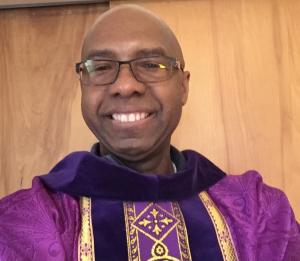 The Rev’d Kevin Barron is an ordained priest of the Episcopal Church in the Diocese of Central Pennsylvania. He entered the priesthood after thirty-six years of service at a major research university, and serves in a variety of capacities throughout the diocese. Each summer he teaches Becoming A Beloved Community, a course about systemic racism for the Stephenson School for Ministry.
The Rev’d Kevin Barron is an ordained priest of the Episcopal Church in the Diocese of Central Pennsylvania. He entered the priesthood after thirty-six years of service at a major research university, and serves in a variety of capacities throughout the diocese. Each summer he teaches Becoming A Beloved Community, a course about systemic racism for the Stephenson School for Ministry.


